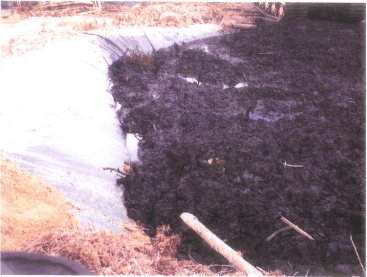
Contaminated soil from an in situ flow-to-surface event in northern Alberta
In my latest article, I examine 4 related events in which processes that superheat bitumen into a hot emulsion deep underground forced it to Earth’s surface…rather than having it stay put for long enough to be pumped out. I have a lot of data I gathered on the governance response, but this article targets just one part of it (the rest will be in a new book I’m writing on Alberta). Namely, what was the official ’cause’ of the bitumen flowing to the surface?
Here is the paper (free for 50 days from this link, and available from my publications page). If you have a subsription to Political Geography click here.
At first glance, the answer seems straightforward: the technology used to extract the bitumen was clearly the driving force. But things are more complicated than this for a variety of reasons. The most interesting part for the argument in this paper is how Earth’s deep history (i.e. geologic time) was used to explain causal relationships as ancient marine environments, glacial advances and retreats, and floods from the geologic record were used to explain causal relationships in the present. By looking closely at this case, we can see how geologic and human time are made commensurate with one another…that is, how they are put on the same scale of time.
Of course, these temporal scales are not brought together in just any old fashion. Instead, they are brought together in ways that fit with existing governance structures designed to extract value from land. That is, from the structures put in place through settler colonialism. As it happens, settler colonialism has a very peculiar, and quite flawed, idea of time underpinning it and which make it appear natural despite its violent effects on Indigenous peoples, lands, and relations. I have created the term ‘settler geology’ as a shorthand to refer to how this temporal framework is extended to make Earth’s deep history a natural fit with the cultural time of settler colonialism.
Those who follow debates around the Anthropocene will be familiar with a very prominent premise: that the scale of the Anthropocene is incommensurate with human time. Or, in other words, that the two not only operate on vastly different time scales but that, in addition, geologic time cannot be explained in terms of human time (or vice versa). This premise, and adjacent ideas of incommensurate aspects of the Anthropocene (like Tim Morton’s idea of hyperobjects like climate change that are too big to be candidates for experience) are the target of my latest article in Political Geography. In it, I show how geologic time is made commensurate with the governance of one of the planet’s largest fossil fuel extraction operations: the Alberta oil sands (or tar sands, if you are looking to battle it out over terminology).
Settler geology: Earth’s deep history and the governance of in situ oil spills in Alberta
Abstract
Alberta’s bitumen industry is frequently identified as a key site of environmental politics in the Anthropocene owing to the scale of its fossil fuel extraction operations. While popular images of surface mining activities often focus these discussions, approximately 80% of the bitumen reserves in the Canadian province lie too deep for surface mining and are extracted through in situ technologies, including processes that inject high-temperature, high-pressure steam to mobilize geologic formations of the tar-like fossil fuel. This article examines how in situ extraction was governed in response to four flow-to-surface (FTS) events in which bitumen unexpectedly migrated to Earth’s surface as the result of in situ operations. The governance response to these events is of particular interest because it counters the assertion that existing governance institutions operate on time scales that are incommensurate with those relevant to the Anthropocene. The Alberta case shows the opposite owing to how Earth’s deep history was used to provide temporal syntax for a geotechnical debate that ensued over what caused the FTS events. By detailing the controversy over what caused the FTS events, and the search for “enabling conditions” that would link causal explanations to the spatial distribution of the four bitumen seeps, Earth’s deep history was also made commensurate with the political geography of settler colonialism in Alberta. The article introduces and develops the notion of ‘settler geology’ in order to capture the naturalization of geologic forms of reasoning about Earth’s deep history, the geologic force of anthropogenic in situ operations, and the temporal framework of settler colonial governance in Alberta.
Leave a comment